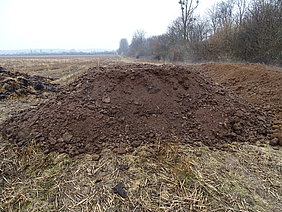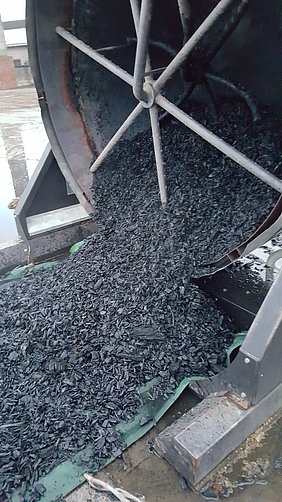Preferably in a biogas plant! This is the conclusion of a study by Potsdam scientists recently published in the scientific periodical Journal of Cleaner Production. A new modelling approach provides more robust results on the emission of climate-relevant gases from manure management and, thus, offers decision support for the climate-friendly use of poultry manure.
Production of broilers has doubled in the past 20 years. Worldwide, more than 70 billion animals are slaughtered each year, and this trend is rising. With the number of animals, the amount of manure produced also increases. Poultry manure, consisting of excrements, feathers and bedding material, is rich in nutrients and therefore appreciated as fertilizer in agriculture. However, its high nitrogen content and the relatively rapid mineralisation can cause nitrogen leaching into the groundwater as well as considerable emissions of pollutants and greenhouse gases, in particular ammonia, methane and nitrous oxide. Options for a climate and environmentally friendly and at the same time economic use of poultry manure are therefore becoming increasingly important.
In a comparative study, scientists at the Leibniz Institute for Agricultural Engineering and Bioeconomy evaluated four treatments of manure from broiler fattening including the subsequent application on the field with regard to the potential direct and indirect greenhouse gas emissions for the situation in Germany. The following processes were compared: manure storage and subsequent distribution on the field, composting, anaerobic digestion in a biogas plant, and the use of biomass for the production of biochar.
Previous analyses have shown that not only individual management decisions such as the method and duration of composting are clearly reflected in the results. Factors that were originally developed to estimate emissions at national level, but which are often also used when considering individual measures, also have a major impact on the results. "These emission factors were derived from a large number of studies. They are intended to be representative of the mean situation at a wider geographical scale. However, local conditions can deviate significantly, so that a misleading perception of reliable results can easily arise", explains ATB scientist Dr. Ulrich Kreidenweis.
This study therefore developed a new model for calculating greenhouse gas emissions, integrating the influence of different management options as well as uncertain parameters. In addition, interactions between the individual processes were taken into account, for example in cases when high emissions from manure during the composting process mean that the composted material will emit less after it has been spread on the field.
The study clearly indicates that biogas production from poultry manure is associated with the lowest greenhouse gas emissions. This is mainly due to the substitution of mineral fertilisers and the production of electricity: anaerobic digestion uses the energy potential contained in the manure to produce heat and electricity and also reduces nitrous oxide emissions during the digestion process in a closed system. The digestate can be used as a valuable fertiliser that still contains most of the nitrogen.
However, the study also underlines that biogas production needs to be well managed in order to result in low emissions. "Digestates should definitely be stored in a closed tank. Leaks in gas storage tanks and incomplete combustion in the combined heat and power unit have to be prevented in order to keep methane emissions as low as possible", Dr. Ulrich Kreidenweis points out. "High methane losses due to leaks can partially offset the advantage of biogas production".
The second best option proved to be the production of biochar by pyrolysis and the subsequent application in the field as soil additive. When biomass is carbonised, part of the carbon is bound in the long-term in the form of biochar, thus avoiding CO2 emissions when applied to the soil. In terms of the climate balance, this effect together with low methane emissions during the production compensates for nutrient losses and the resulting lower fertilisation effect. However, these calculations could not be carried out with practice data. Further research is needed, in particular to make it possible to calculate emissions from the decomposition of biochar more reliably over extended periods of time.
Composting proved to be the least favourable option. In contrast to simple storage, the repeated turnover during the composting process causes higher emissions, mainly due to losses of nitrogen compounds.
"For the management option biogas, our comparison provided very robust results," summarises Dr. Ulrich Kreidenweis. "In the case of composting, however, we observed that the method of calculation sometimes had a greater influence on the results than, for example, the question of whether the compost is transported for short or long distance. In order to obtain reliable information on the climate balance in such cases, further field tests are necessary to help us understand the influence of local conditions and thus reduce the uncertainties".
Original publication:
Kreidenweis, U.; Breier, J.; Herrmann, C.; Libra, J.; Prochnow, A. (2020): Greenhouse gas emissions from broiler manure treatment options are lowest in well-managed biogas production. Journal of Cleaner Production. https://doi.org/10.1016/j.jclepro.2020.124969
Contact:
Dr. Ulrich Kreidenweis
Tel.: +49 (0)331 5699-219, Email: ukreidenweis@atb-potsdam.de
Prof. Dr. Annette Prochnow
Tel.: +49 (0)331 5699-210, Email: aprochnow@atb-potsdam.de
Helene Foltan - Presse- und Öffentlichkeitsarbeit
Tel.: +49 (0)331 5699-820, Email: presse@atb-potsdam.de
Leibniz-Institut für Agrartechnik und Bioökonomie e.V. (ATB)
Max-Eyth-Allee 100, 14469 Potsdam
Research of the Leibniz Institute for Agricultural Engineering and Bioeconomy (ATB), at the interface of biological and technical systems, aims to provide the basis for sustainable bio-economic production systems. ATB develops and integrates new technologies and management strategies for a knowledge-based, site-specific production of biomass and its use for food, as bio-based products and energy sources - from basic research to application.
Aiming at closed substance cycles, ATB intensively researches on strategies for the utilisation of agricultural residues by anaerobic digestion for biogas production as well as thermochemical treatments (pyrolysis and hydrothermal carbonisation) of biomass for the production of biochar, which can be used e.g. as soil additive or energy source.


